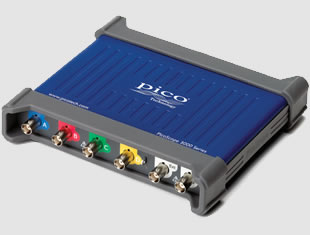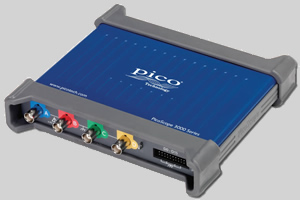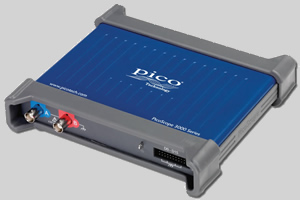- HUGE 512 MS Buffer Size
- 200 MHz Digital Channels
- 10 GS /s Repetitive Sampling
- 250 MHz Spectrum Analyse
- Built In Function Generator/AWG
- 250 MHz Analog Bandwidth
- 1 GS/s Real Time Sampling
- Advanced Digital Triggers
- Super Speed USB 3.0
Connected & Powered
The PicoScope 3000 Series Mixed Signal Oscilloscopes (MSOs) are 2+16 channel & 4+16 channel, 8 bit resolution oscilloscopes. This means that along with 2 & 4 analog channel options, the PicoScope 3000 Series MSOs also have 16 digital inputs. The result? You can view your digital and analog signals simultaneously.
All 3000D Models use a USB 3.0 interface. USB 3.0 offers a tenfold increase in theoretical transfer speeds over USB 2.0.
The PicoScope 3000 series also includes the PicoScope 3425. This has differential inputs that allow you to measure signals that are not referenced to ground.
Power, Portability, and Performance
The PicoScope 3000 Series USB powered PC oscilloscopes are small, light, and portable, while offering a range of high performance specifications required by engineers in the lab or on the move.
These oscilloscopes offer 2 or 4 analog channels, plus an additional 16 digital channels on the MSO models. The flexible, high resolution display options enable you to view and analyze each signal in fine detail.
Supported by the advanced PicoScope 6 software, these devices offer an ideal, cost-effective package for many applications, including embedded systems design, research, test, education, service, and repair.
High Bandwidth And Sample Rate
Despite a compact size and low cost, there is no compromise on performance. With input bandwidths up to 250 MHz, the PicoScope 3000 Series scopes can be used for a wide range of signal types from DC and baseband into RF and all the way up to VHF.
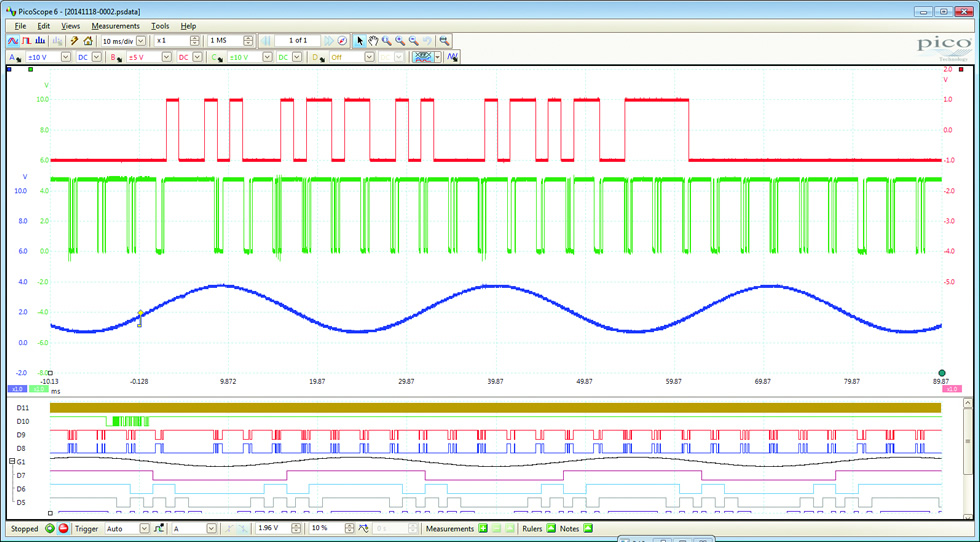
Deep Memory
PicoScope 3000 Series oscilloscopes offer a huge buffer memory, allowing them to sustain high sampling rates across long timebases. For example, using the 512 MS buffer the PicoScope 3206 and 3406 models can sample at 1 GS/s all the way down to 50 ms/div (500 ms total capture time).
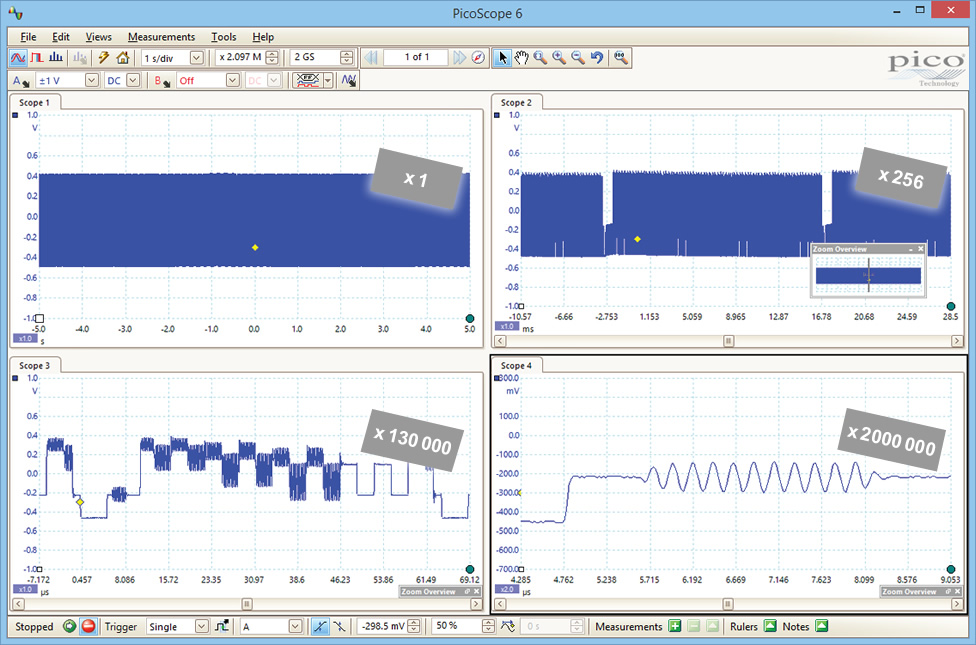
Powerful tools are included to allow you to manage and examine all of this data. As well as functions such as mask limit testing and color persistence mode, the PicoScope 6 software enables you to zoom into your waveform by several million times. A zoom overview window allows you to easily control the size and location of the zoom area.
Up to 10 000 waveforms can be stored in the segmented waveform buffer. The Buffer Overview window then allows you to rewind and review the history of your waveform. No longer will you struggle to catch an infrequent glitch.
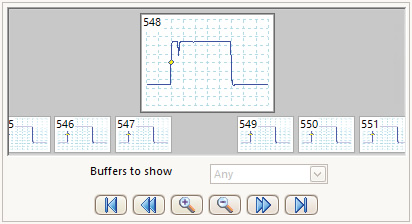

Serial Decoding
The deep-memory PicoScope 3000 Series oscilloscopes include serial decoding capability across all channels, and can capture thousands of frames of uninterrupted data, making them ideal devices for the job.
The decoded data can be displayed in the format of your choice: in graph, in table, or both at once.
• In graph format shows the decoded data beneath the waveform on a common time axis, with error frames marked in red. These frames can be zoomed to investigate signal integrity (SI) issues.
• In table format shows a list of the decoded frames, including the data and all flags and identifiers. You can set up filtering conditions to display only the frames you are interested in, search for frames with specified properties, or define a start pattern to signal when the program should list the data.
PicoScope also includes options to import and export the decoded data using a Microsoft Excel spreadsheet.
| Serial protocols |
| UART/RS-232 |
| SPI |
| I2C |
| I2S |
| CAN |
| LIN |
| FLexRay |
| USB |
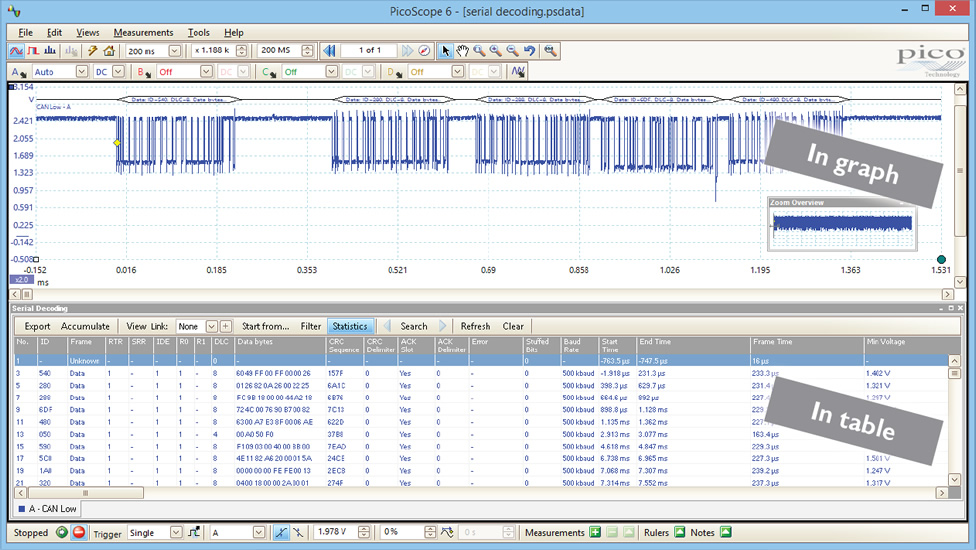
Function Generator
PicoScope 3000 Series oscilloscopes all include both a built-in function generator and an arbitrary waveform generator (AWG), allowing you to create standard and custom-defined waveform outputs.
The function generator includes sine, square, triangle, DC voltage, and a number of other common modes as standard. The capability to generate white noise and pseudo-random binary sequence (PRBS) outputs is also included. In addition to basic controls to set level, offset and frequency, more advanced controls allow you to sweep over a range of frequencies and trigger the generator from a specified event. Combined with the spectrum peak hold option, this becomes a powerful tool for testing amplifier and filter responses.
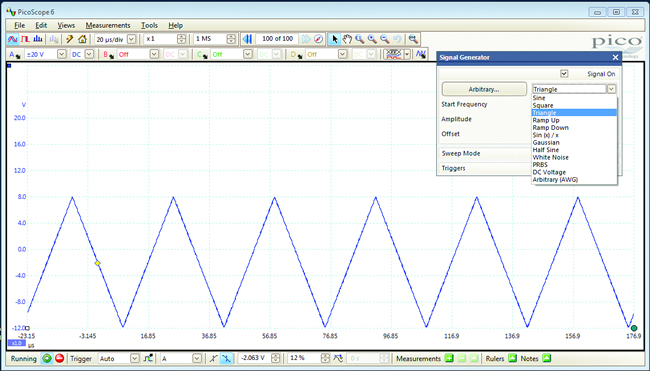
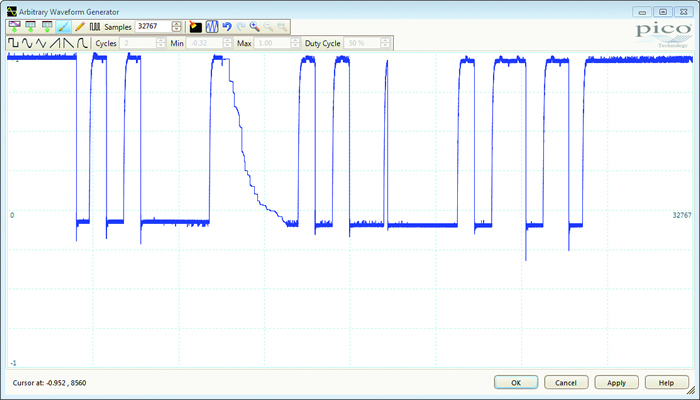
Arbitrary Waveform Generator
All PicoScope 3000D Series oscilloscopes also include a built-in arbitrary waveform generator (AWG). With most competing oscilloscopes, you would need to purchase separate hardware to gain this functionality, taking up extra space on your workbench.
The AWG can be used to emulate missing sensor signals during product development, or to stress test a design over the full intended operating range.
Waveforms can be created or modified using the AWG editor, imported from oscilloscope traces, or loaded from a spreadsheet; with the PicoScope's integrated hardware, these tasks can be performed instantly and easily.
HAL3 Hardware Acceleration
Many oscilloscopes struggle when deep memory is enabled: the screen update rates can slow and the controls can become unresponsive. The PicoScope 3000D Series oscilloscopes avoid this limitation with the use of a dedicated hardware acceleration engine. This parallel design enables the oscilloscope to intelligently compile the waveform image from the raw data stored in its memory before transferring it to the PC, so that the USB connection and PC's processor performance do not limit capture rates. This allows the continuous capture and display of over 440 000 000 samples every second. PicoScope oscilloscopes manage deep memory far more effectively than competing PC-based and benchtop models.
The PicoScope 3000D Series is fitted with third-generation hardware acceleration (HAL3), which allows high waveform update rates and faster segmented memory and rapid trigger modes. In most cases the data collection speed of the PicoScope will be faster than the USB transfer rate, so information has to be buffered in high-speed memory on the device. HAL3 allows even deep-memory PicoScopes to maintain fast waveform update rates regardless of the buffer size.
For example, the PicoScope 3206D can sample at 1 GS/s on timebases as long as 20 ms/div, capturing 200 million samples per waveform, and still update the screen several times per second. That's around 500 million sample points each second!
Less intelligent oscilloscopes attempt to reduce the amount of data transferred by using simple decimation, transferring only every nth sample. This results in the majority (up to 99.999%) of data being lost and a lack of high-frequency information. PicoScope deep-memory oscilloscopes perform data aggregation instead. Dedicated logic divides the memory into blocks and transfers the minimum and maximum values of each block to the PC, preserving the high-frequency detail.
For example, a waveform with 100 million samples may be divided into 1000 blocks of 100 000 samples each, with only the minimum and maximum values for each block being transferred to the PC. If you zoom into the waveform, the oscilloscope will again divide the selected area into blocks and transfer the minimum and maximum data so that fine detail is viewable without any delay.

In the example above, both waveforms show the same signal using different types of hardware acceleration. The top waveform has used the aggregation possible with a PicoScope, and as a result the high-frequency spikes are preserved. The bottom waveform has used traditional decimation, showing a loss of high-frequency information.
In parallel with the data aggregation, other data such as average values are also returned to speed up measurements and to reduce the load on the PC's processor.
Signal Integrity
Most oscilloscopes are built down to a price. PicoScopes are built up to a specification.
Careful front-end design and shielding reduces noise, crosstalk, and harmonic distortion. Years of oscilloscope design experience can be seen in improved bandwidth flatness, low distortion, and excellent pulse response. We are proud of the dynamic performance of our products, and publish their specifications in detail.
The result is simple: when you probe a circuit, you can trust in the waveform you see on the screen.
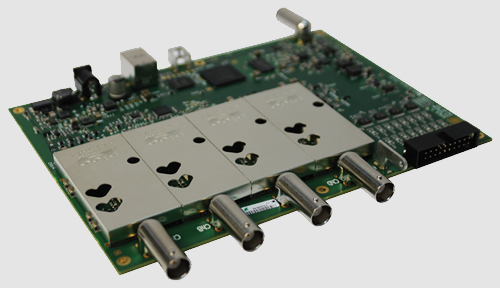
High-speed Data Acquisition and Digitizer
The supplied drivers and software development kit (SDK) allows you to write your own software or interface to popular third-party software packages such as National Instruments' LabVIEW and MathWorks' MATLAB.
The driver supports data streaming, a mode which captures gap-free continuous data over USB direct to the PC at rates of up to 125 MS/s subject to PC specifications). The capture size is limited only by available PC storage.
Beta drivers are also available for use with Raspberry Pi, BeagleBone Black, and similar ARM-powered platforms. These drivers enable you to control your PicoScope using these small, single-board Linux computers.

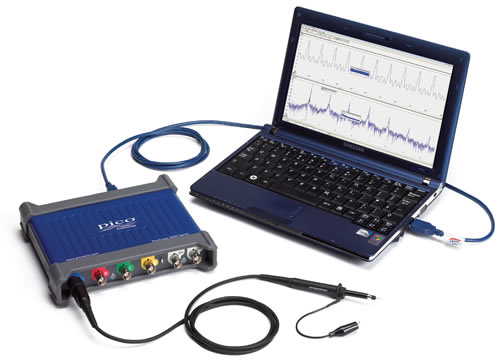
Benefits of USB Connectivity
All PicoScope 3000D Series oscilloscopes feature a SuperSpeed USB 3.0 connection, providing high-speed data transfer whilst remaining compatible with older USB systems. A USB oscilloscope offers many benefits over a traditional benchtop device:
• Size and portability
These compact, portable scopes are ideal for use both in the lab and in the field. Unlike traditional benchtop instruments, PicoScopes take
up less space on your workbench and easily fit in to your laptop bag or tool case. PicoScope 3000D Series oscilloscopes can be powered
from the USB port, removing the need to carry an external power supply.
• Flexibility
The PicoScope software offers a breadth of advanced features via a user-friendly interface. As well as the standard Windows installation,
PicoScope Beta software also works effectively on Linux and Mac operating systems, giving you the freedom to choose which platform you
operate your PicoScope from.
• File sharing
PC connectivity makes printing, copying, saving and emailing your data from the field quick and easy.
• Advanced display
Laptop screens and desktop monitors offer higher resolution, larger size and greater flexibility for displaying your signal.
• Value
With PicoScope you only pay for the specialised scope hardware. You don't need to repurchase the hardware already available on your PC.
• Updates
As the scope is connected to your computer, both the PicoScope software and the device's firmware can be quickly updated free of charge.
• Fast Transfer Rates
A USB 3.0 connection provides fast saving of waveforms when using the PicoScope software, and fast gap-free continuous streaming of up
to 125 MS/s when using the SDK. The quick transfer rates ensure a fast screen update speed, even when collecting large amounts of data.
USB connectivity and power
All PicoScope 3000 Series oscilloscopes are supplied with a USB 3.0 cable for SuperSpeed connectivity. A double-headed USB 2.0 cable is also supplied, to provide additional power when using the oscilloscope with older PCs.
For PicoScope 3000 models with 4 analog channels, the supplied AC power adaptor may be required if the USB port(s) provide less than at total of 1200 mA to the instrument.
 USB 3.0 cable
USB 3.0 cable
 USB 2.0 cable, double-headed
USB 2.0 cable, double-headed
Application Examples
Testing on the move
The PicoScope 3000 Series oscilloscopes slip easily into a laptop bag, so you don't need to carry bulky benchtop instruments to perform on-site troubleshooting. Being powered via a USB connection, your PicoScope can simply be plugged into your laptop and used for measuring wherever you are. The PC connection also makes saving and sharing your data quick and easy: in a matter of seconds you can save your scope traces to review later, or attach the complete data file to an email for analysis by other engineers away from the test site. As PicoScope 6 is free to download by anyone, colleagues can use the full capabilities of the software, such as serial decoding and spectrum analysis, without needing an oscilloscope themselves.
Embedded Debugging
You can test and debug a complete signal-processing chain using a PicoScope 3406D MSO.
Use the built-in arbitrary waveform generator (AWG) to inject single-shot or continuous analog signals. The response of your system can then be observed in both the analog domain, using the four 200 MHz input channels, and in the digital domain with 16 digital inputs at up to 100 MHz. Follow the analog signal through the system while simultaneously using the built-in serial decoding function to view the output of an I2C or SPI ADC.
If your system drives a DAC in response to the analog input changing, you can decode the I2C or SPI communication to that as well as its analog output. This can all be performed simultaneously using the 16 digital and 4 analog channels.
Using the deep 512 MS buffer memory, you can capture the complete response of your system without sacrificing the sampling rate, and zoom in on the captured data to find glitches and other points of interest.
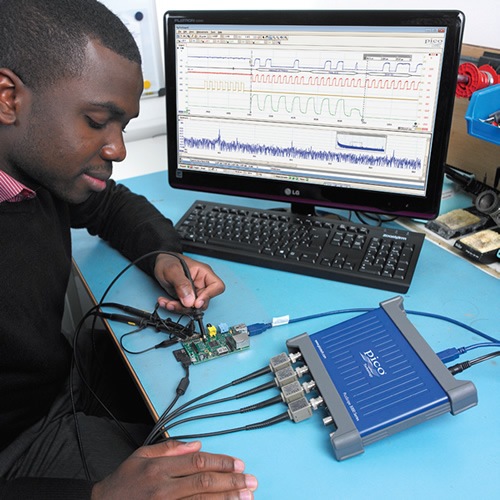
|
|||||||||||||||||||||||||||||||||||||||||||||||||||||||||||||||||||||||||||||||||||||||||||||||||||||||||||||||||||||||||||||||||||||||||||||||||||||||||||||||||||||||||||||
|
||||||||||||||||||||||||||||||||||||||
|
||||||||||||||||||||||||||||||||||||||
|
||||||||||||||||||||||||||||||||||||||
|
||||||||||||||||||||||||||||||||||||||
|
||||||||||||||||||||||||||||||||||||||
|
||||||||||||||||||||||||||||||||||||||
|
||||||||||||||||||||||||||||||||||||||
|
||||||||||||||||||||||||||||||||||||||
|
||||||||||||||||||||||||||||||||||||||
|
||||||||||||||||||||||||||||||||||||||
|
||||||||||||||||||||||||||||||||||||||
|
||||||||||||||||||||||||||||||||||||||
|
||||||||||||||||||||||||||||||||||||||
|
||||||||||||||||||||||||||||||||||||||
|
||||||||||||||||||||||||||||||||||||||
|
||||||||||||||||||||||||||||||||||||||
| 2 Channel Models | ||||||||
|
||||||||
| 4 Channel Models | ||||||||||||||||||
|
|
|||||||||||||||||
| 2 Channel MSO Models | |||||||||
|
|
||||||||
| 4 Channel MSO Models | |||||||||||||||||
|
|
||||||||||||||||
Kit Contents
All PicoScope 3000D Series oscilloscope kits contain:
- PicoScope 3000 Series oscilloscope
- Switchable x1/x10 probes (2 or 4) in carrying case
- Quick Start Guide
- Software and reference CD
- USB 3.0 cable
- Double-headed USB 2.0 cable
- AC power adaptor (4-channel models only)
MSO kit contents
PicoScope 3000D MSO kits also contain:
- TA136 digital cable
- TA139 pack of 10 test clips (x2)

